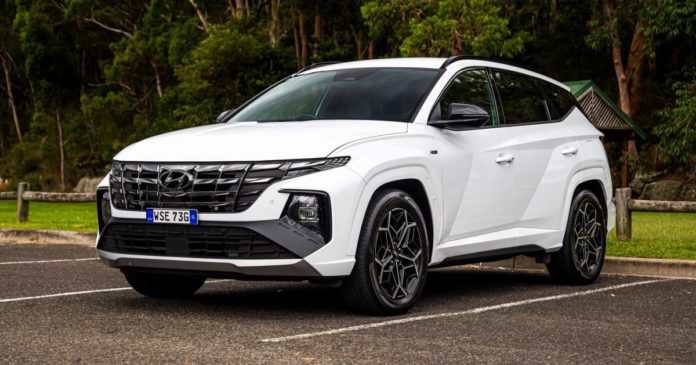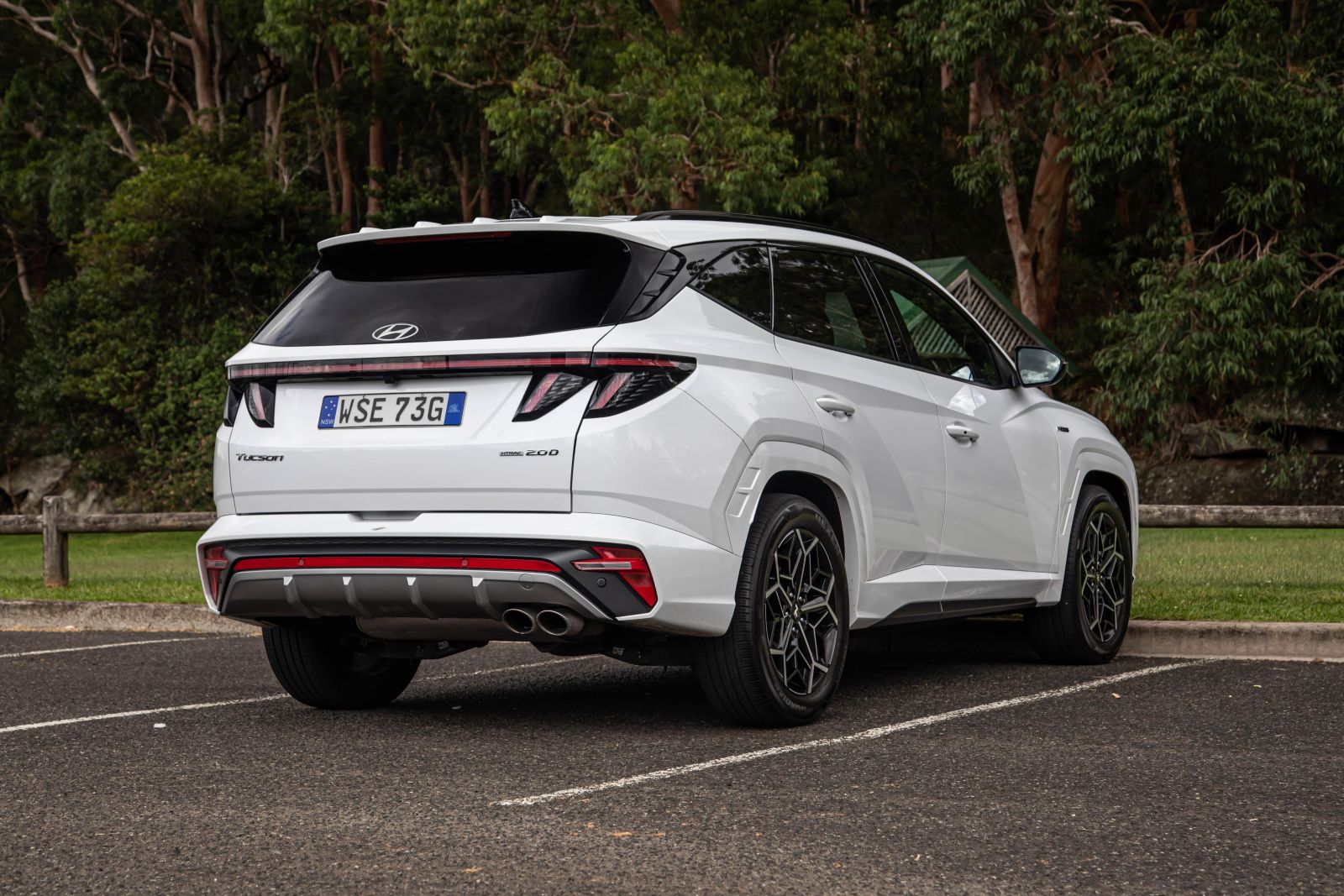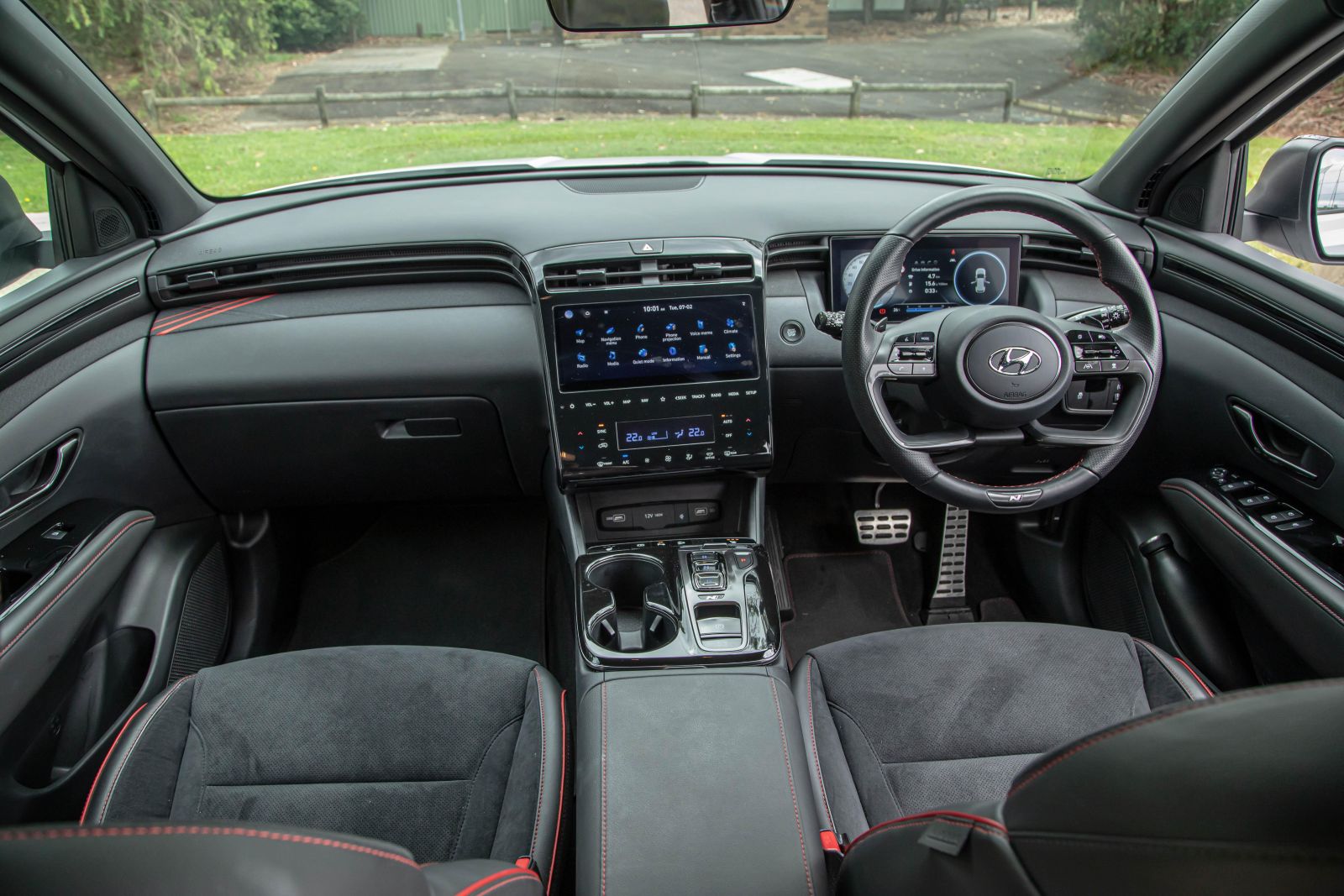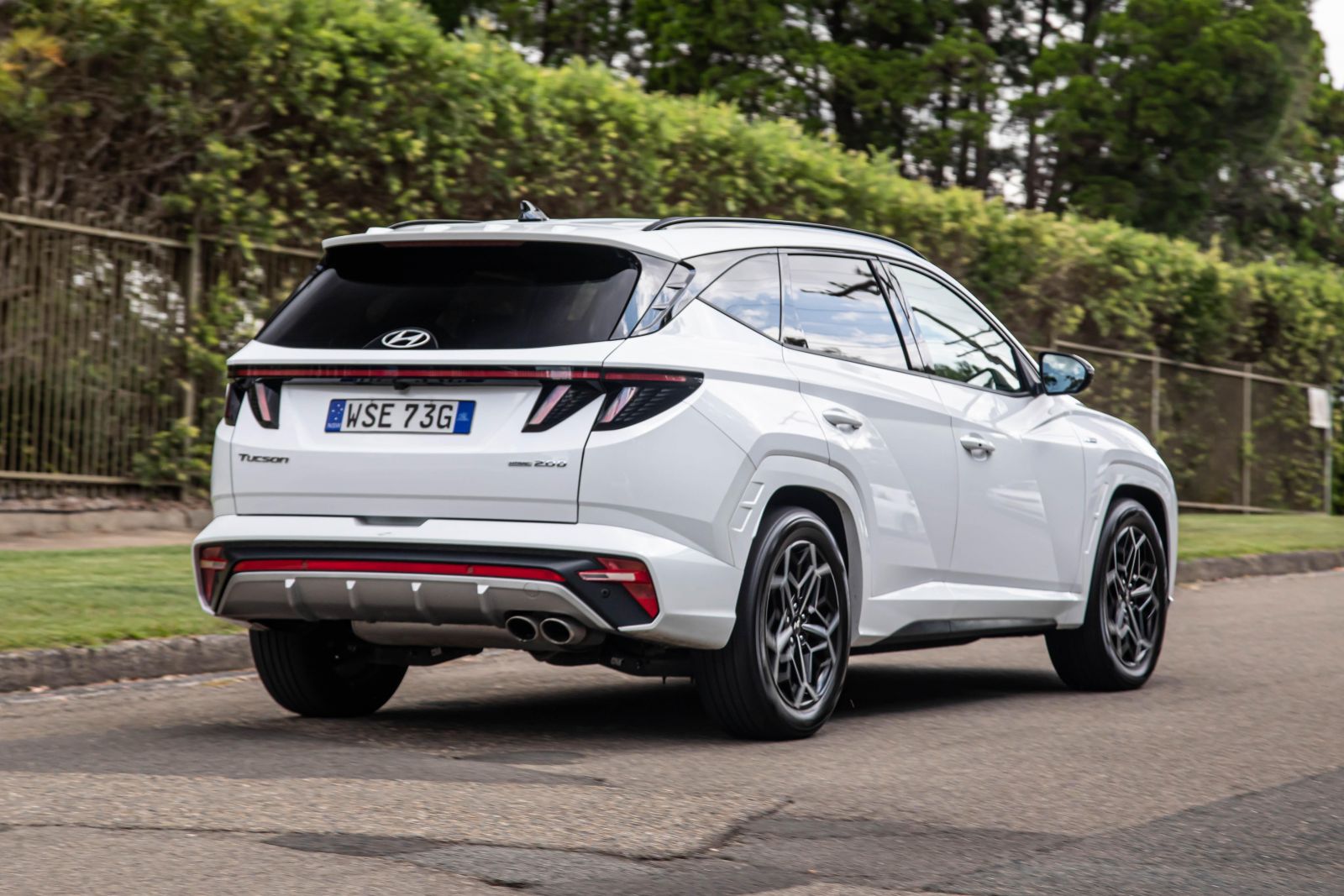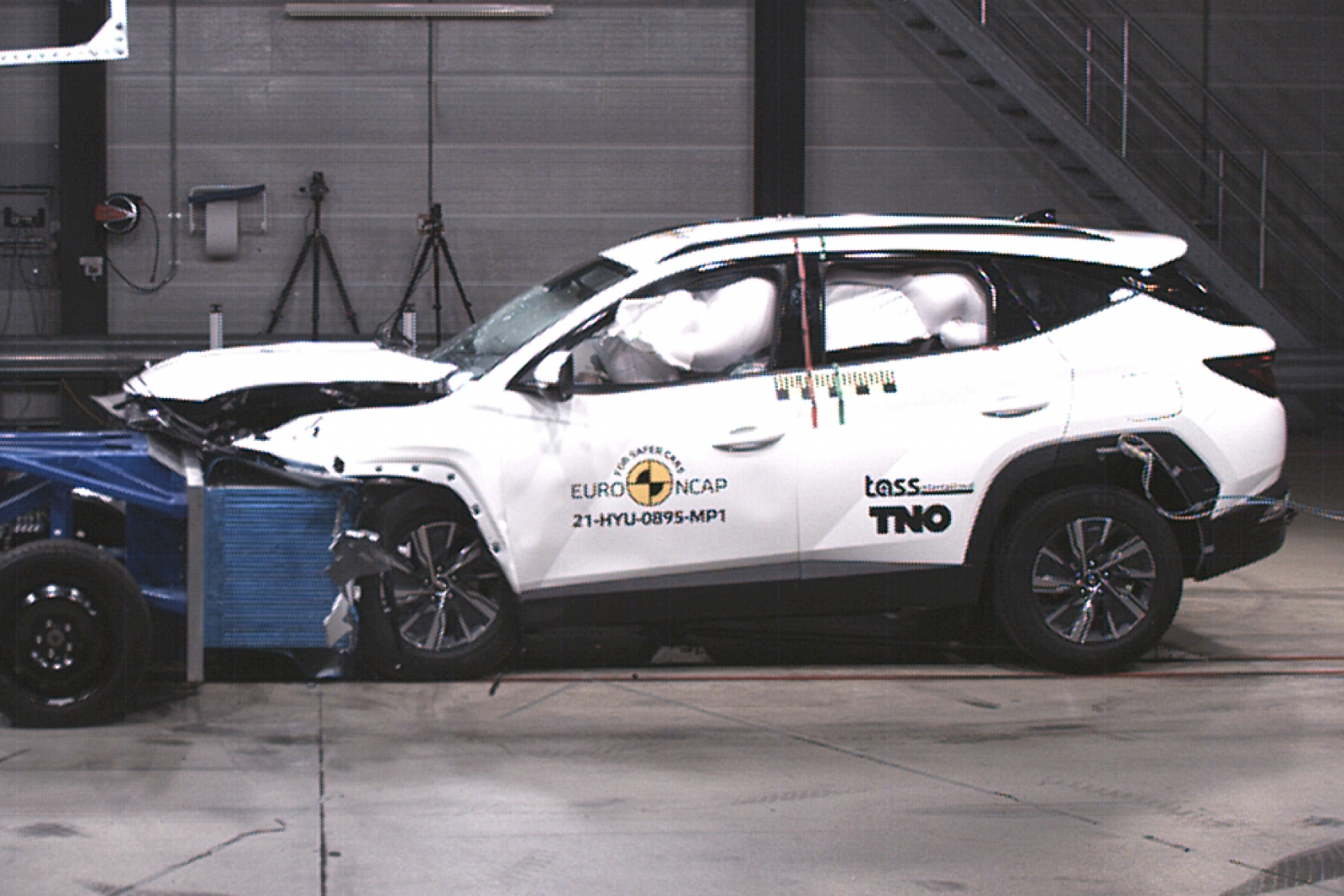If you asked me to choose my ideal 2023 Hyundai Tucson, this would be it.
I think the Elite trim is the sweet spot in the range, and I reckon the 2.0-litre turbo-diesel engine and all-wheel drive is the best powertrain combo you can get in the local range.
Add to that the optional N Line package, and you’ve got yourself a sporty looking, high-tech feeling and cleverly packaged midsize SUV.
Shame it’s quite expensive to spec it as such. Because otherwise it’s pretty compelling in plenty of ways.
I’ll run you through why I think this is the pick of the mix in this review.
How much does the Hyundai Tucson Elite N Line 2.0D AWD cost?
There are so many choices in the Hyundai Tucson range, but this one has a list price of $45,900 plus on-road costs for the Elite Diesel AWD; but if you add the N Line package, it’ll plonk another $2500 on top.
So, you’re looking at $48,400 before you add on-road costs. That’s a lot of dollars, admittedly, considering – on list price, at least – you can get a Kia Sportage SX+ with the same diesel powertrain for less ($47,250), or a Mazda CX-5 D35 Touring Active for $47,000.
And then, if diesel isn’t your thing, the excellent Toyota RAV4 GXL AWD Hybrid is $47,100, and the top-spec Subaru Forester 2.5i-S tops out at $46,340 (wouldn’t bother with the Forester Hybrid, honestly).
What is the Hyundai Tucson Elite N Line 2.0D AWD like on the inside?
Sit in an Elite model, then in an N Line model, and could be persuaded that they are different vehicles altogether, such is the amount of difference the N Line package adds to the Tucson’s cabin.
The standard fare in an Elite grade is definitely geared more towards luxury, while the N Line version is for those who like their interiors sporty but also very dark.
That’s because the cabin is trimmed with black headlining, and there are black fabric elements with red crosshatch stitching bits on the dash as well. Of course, you get sports seats with leather and suede trim and N logos, and there’s red trim on those chairs as well.
Combined with a mass of black plastic trim, this is a very cocoon-like interior. But, it’s lifted with the twin 10.25-inch screens, which are bright and colourful.
It would be good if Hyundai also had ambient lighting in N Line upgrades, because it would make the interior just a bit more airy feeling.
The controls for the air-con and media take some getting used to, as they are a haptic-style touch-sensitive setup, which can be hard to get to grips with (literally) when you’re driving.
At least it’s a bit more usable than some other cars which run everything through the screen.
There’s sat nav (which includes new cloud-based navigation thanks to the addition of Hyundai’s BlueLink tech), or you can connect your phone via USB for smartphone mirroring (Apple CarPlay and Android Auto).
There is good storage, including cup holders between the seats, a caddy in front of the gear selector for a phone/wallet/keys, bottle holders in the doors, a covered centre console bin, and a section under the ‘bridge’ of the centre console for bigger items.
When it comes to back seat space, if you want a roomy and comfortable experience, this car delivers.
It has ample space for an adult my size (182cm/6’0) to sit behind my own driving position, and with room to spare. I had inches of legroom, good headroom and toe wiggle space, plus you can fit three adults my size across the back bench if you need to.
If you have children, there are ISOFIX points in the window seats and top-tether attachments for all three spots. There are directional vents in the back, and a pair of USB charge points as well.
Storage is sorted by way of a pair of cupholders in a flip-down armrest, bottle holders in the doors, and mesh map pockets on the backs of both front seats. I don’t love those, because things can fall through them – but I do appreciate that the plastic backing on the seats is a bit more kid-resistant than cloth pockets.
The boot space is pretty family-friendly, too, with a huge 539 litres of cargo capacity on offer.
There’s a couple of hooks for shopping bags, a cargo cover, and a full-size spare wheel – which isn’t something you get in every family SUV.
What’s under the bonnet?
This one is the diesel, and it’s the best powertrain option in the current-gen Tucson range, if you ask me.
It’s a 2.0-litre four-cylinder turbo-diesel engine, and it produces 137kW of power (4000rpm) and a whopping 416Nm of torque (2000-2750rpm). The Tucson diesel comes with an eight-speed automatic transmission, and is all-wheel drive.
I know diesel isn’t a very forward-thinking powertrain in 2023, but the fact is that this is the easiest to live with, and most likeable option in the Tucson range.
I’ve driven them all, and the 2.0-litre petrol is borderline underpowered for that application, while the zesty turbo-petrol 1.6-litre model with its dual-clutch auto is great at pace, it isn’t much fun in stop-start driving.
If Hyundai finally offers the hybrid option available overseas in Australia this year or next, it might be the one to sway me away from diesel – but it’d want to be good.
How does the Hyundai Tucson Elite N Line 2.0D AWD drive?
Don’t go thinking that because you got the N Line pack that you’re going to get a N-like drive experience, because that simply isn’t the case.
But honestly, I don’t think that matters, because the drive experience in the Tucson is relatively inoffensive, at least with the diesel powertrain.
That engine is a corker, offering plenty of pulling power at speed, but there is some lag to contend with from a standing start. It’s not annoying, and you learn to drive around it, but it does better work beyond the traffic lights.
The eight-speed auto is smooth and smart, allowing the engine to make the most of its torque band and pull the car without having to shuffle too much through the gears. There are paddle shifters if you want to act like an N driver, but again, that’s not this car’s purpose.
It steers fine – easy to park, easy to negotiate roundabouts or tight streets, and light but accurate response from the wheel. It’s not as involving as a Mazda CX-5 though, if you want a more “feelsome” experience.
The suspension is pretty impressive as well, offering a comfortable ride in most situations.
Those 19-inch N Line wheels and low-profile tyres can pick up on sharp edges more than the 18s of the standard Elite would, but that 235/55/19 Nexen rubber also offers a bit more alacrity, so I think it’s worth it.
There’s some turbo-diesel rumble to contend with, and that’s about the noisiest part of the drive experience because it’s otherwise a pretty hushed and enjoyable thing to spend time in.
What do you get?
Okay, it’s complicated. Because when you buy the Elite you score plenty of gear, but if you add the N Line pack, that list expands – I’ve put it in simple terms below.
Tucson Elite highlights:
- 18-inch alloy wheels
- Front parking sensors
- Advanced Rear Occupant Alert
- Rear privacy glass
- Rain-sensing window wipers
- Solar control windshield glass
- 10.25-inch touchscreen infotainment system
- Apple CarPlay, Android Auto (wired)
- Satellite navigation
- Dual-zone climate control
- Keyless entry with push-button start
- Remote start
- Shift-by-wire gear selector (AWD models only)
- Paddle shifters (AWD models only)
- Luggage net
- Black leather upholstery
- Heated front seats
- 10-way power driver’s seat adjustment
N Line Package ($2500) adds:
- 19-inch N Line alloy wheels
- N Line exterior body kit
- N Line front and rear bumpers
- N Line rear spoiler
- Body-coloured cladding
- N Line front grille
- N Line daytime running lights
- LED headlights
- Auto high-beam
- LED tail lights with black-tinted lens
- N Line skid plate
- 10.25-inch digital instrument cluster
- Metal pedals
- Leather and suede upholstery
Worth noting that even at almost $46K before on-road costs, the non-N Line Elite still has dull halogen headlights. Yuck.
Is the Hyundai Tucson Elite N Line 2.0D AWD safe?
The Hyundai Tucson range was awarded a five-star ANCAP safety rating – but that score was based on testing conducted of the short-wheelbase European-market model by Euro NCAP in 2021.
The long-wheelbase model we get in Australia is a pretty different car, but ANCAP insists the ratings still apply.
Adult and child occupant protection were rated at 86 and 87 per cent respectively, while vulnerable road user was 66 per cent and safety assistance scored 70 per cent.
Standard safety features include:
- Autonomous emergency braking (AEB)
- Pedestrian, Cyclist detection
- Junction assist
- Camera + Radar
- Adaptive cruise control with stop/go
- Lane Following Assist
- Lane keep assist
- Blind-spot assist
- Rear cross-traffic assist
- Intelligent speed limit assist
- Reversing camera
- Rear parking sensors
- Leading vehicle departure alert
- Safe exit warning
- Tyre pressure monitoring
- 7 airbags incl. front-centre airbag
The 2023 model update saw the introduction of Hyundai’s BlueLink system, which can call emergency services in the event of an accident, among other connected services.
It’s a shame you need to step up to the Highlander to score a surround-view camera, auto-dimming rearview mirror and the clever Blind Spot View Monitor (which displays a live side camera feed in the instrument cluster).
I think it’s a bit slack that Hyundai reserves its Backover AEB system (known as PCA-R – Parking Collision-Avoidance) for the top model, too. That potentially life-saving rear AEB system can detect pedestrians and objects in the path of the car while reversing.
How much does the Hyundai Tucson Elite N Line 2.0D AWD cost to run?
The Hyundai Tucson is covered by a five-year, unlimited kilometre warranty.
There is lifetime capped-price servicing for the car, too – so you can plan 15 years ahead, if you want to. Or, you can pre-pay your maintenance.
Hyundai offers three-, four- and five-year plans, with intervals pegged at 12 months/15,000km. The costs are the same per service no matter the interval for the first five years, at $375 a pop. No discount to prepay either, unlike VW, which cuts hundreds, if not thousands of dollars from maintenance costs if you pre-pay.
The Hyundai Tucson diesel is the most efficient model in the range, with an official combined cycle figure of 6.3 litres per 100 kilometres. Now, I know diesel fuel is expensive, and you’ll need to do the maths about whether the cost difference makes sense for your needs.
But for what it’s worth, I’ve seen around that 6.0L/100km figure for highway touring, but more towards 8.5L/100km for mixed urban and highway driving in the diesel. It has a 54-litre fuel tank, which is the same across the range.
CarExpert’s Take on the Hyundai Tucson Elite N Line 2.0D AWD
It looks good, has a bunch of great tech, is comfy inside and easy to drive, and crucially still slides under that $50,000 mental barrier (before on-road costs, at least).
There are still some things I wish it had, but I reckon I could live without them.
If I was buying a Hyundai Tucson, the Elite N Line Diesel AWD would be the one I’d choose.
Click the images for the full gallery
MORE: Everything Hyundai Tucson

